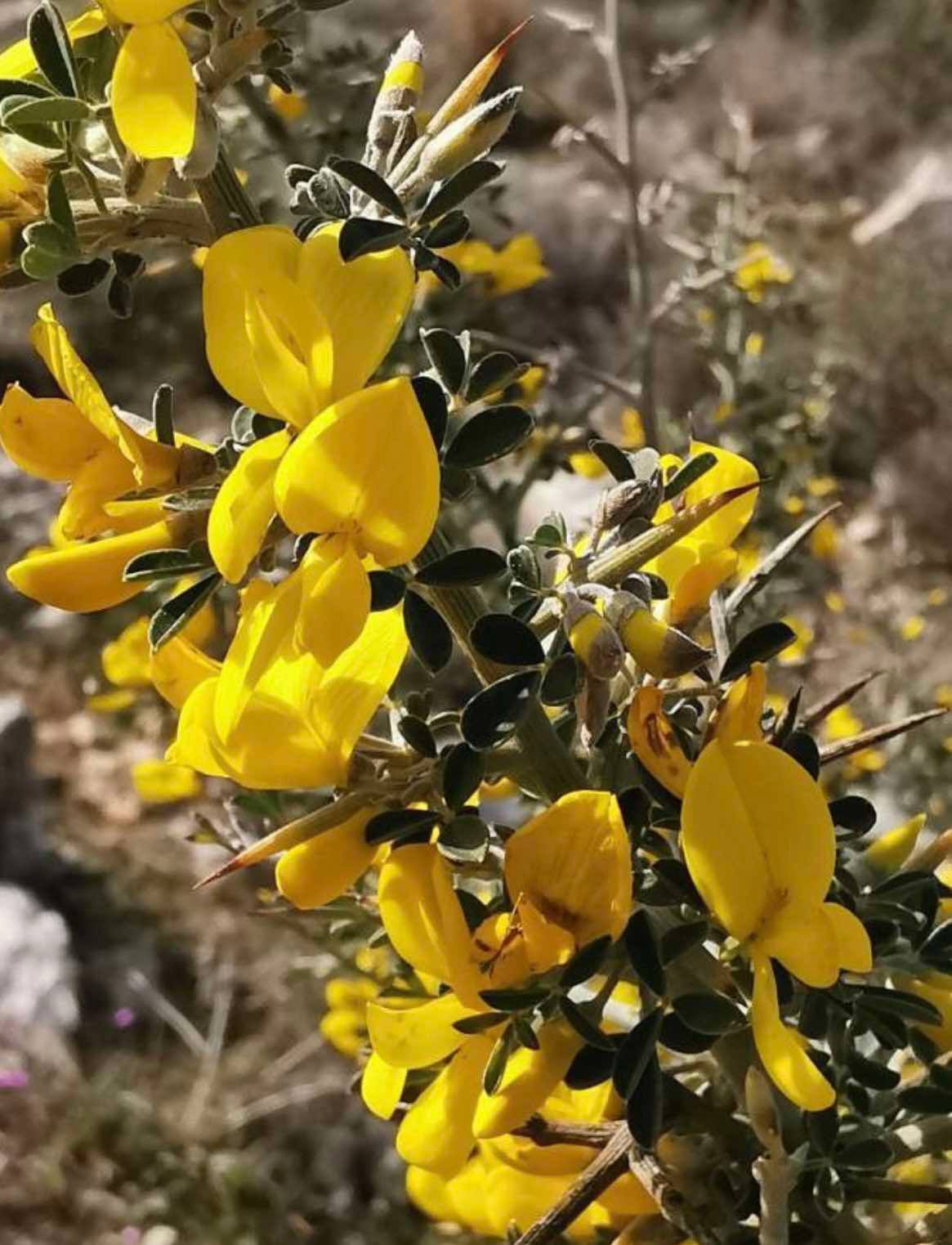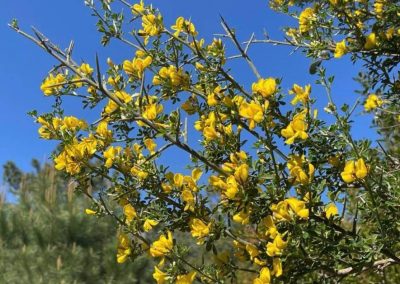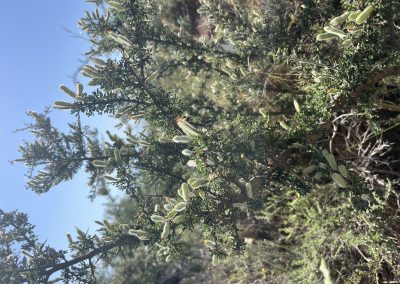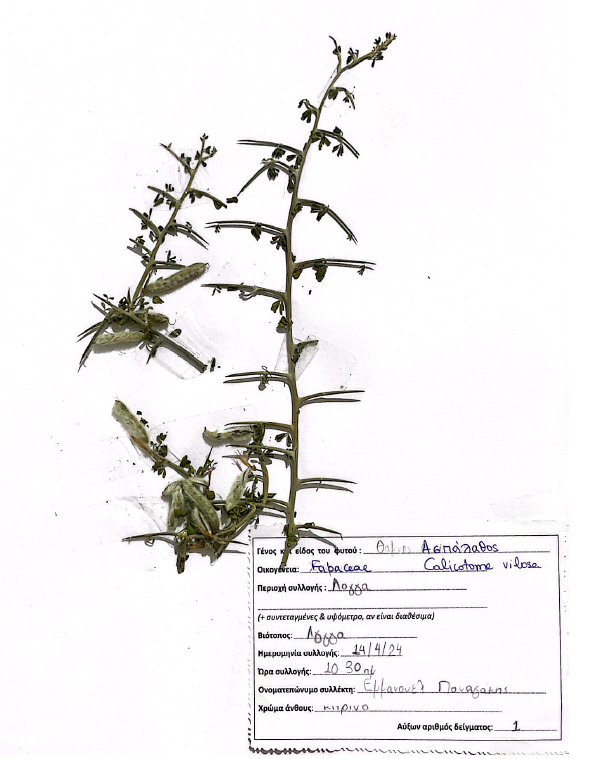Calicotome villosa
Scientific description
Scientific name: Calycotome villosa (Poir.) Link
Common name: Hairy thorny broom, Spiny broom, Yellow thorny broom
Kingdom: Plantae
Phylum (Division): Tracheophyta
Class: Magnoliopsida
Order: Fabales
Family: Fabaceae (Leguminosae)
Genus: Calycotome
Species: Calycotome villosa
Origin:
Native to the Mediterranean Basin — widespread in Greece, Turkey, Israel, Lebanon, Cyprus, and parts of North Africa.
Description:
Dense, spiny shrub up to 1.5 m tall, with green, hairy stems covered in sharp thorns and small trifoliate leaves. Bright yellow, pea-like flowers bloom in spring, often densely clustered. Noted for its villose (soft-hairy) texture, especially on young stems and leaves.
Propagation:
● By seed: Scarification or soaking recommended due to hard seed coat.
● By cuttings: Semi-hardwood cuttings root under mist in warm conditions.
● Self-sowing: Readily propagates in favorable wild conditions.
Ecology:
● Pollinators: Attracts bees and insects.
● Habitat: Dry, rocky soils, open woodlands, scrublands, Mediterranean hillsides.
● Soil: Prefers well-drained, calcareous soils. Drought-tolerant, thrives in full sun.
● Fire ecology: Fire-resistant; resprouts after burns.
Usage:
Used in reforestation and erosion control; occasionally in native or xeriscape gardens. Historically for fencing or hedging due to dense, thorny growth.
Επιστημονική ονομασία: Calycotome villosa (Poir.) Link
Κοινή ονομασία: Ασπάλαθος Μαλλιαρή αγκαθωτή σκούπα, Αγκαθωτή σκούπα, Κίτρινη αγκαθωτή σκούπα
Βασίλειο: Plantae
Φύλο (διαίρεση): Τραχειόφυτα
Τάξη: Magnoliopsida
Οικογένεια: Fabaceae (Leguminosae)
Γένος: Calycotome
Είδη: Calycotome villosa
Προέλευση:
Μεσόγειος — κυρίως Ελλάδα, Τουρκία, Ισραήλ, Λίβανο, Κύπρος και μέρη της Βόρειας Αφρικής.
Περιγραφή:
Πυκνός, αγκαθωτός θάμνος έως 1,5 μ., με πράσινους, τριχωτούς βλαστούς καλυμμένους με αιχμηρά αγκάθια και μικρά τρίφυλλα φύλλα. Φωτεινά κίτρινα, μπιζελοειδή άνθη ανθίζουν την άνοιξη, συχνά πυκνά συγκεντρωμένα. Διακρίνεται για τη βιλλώδη υφή, ιδιαίτερα σε νεαρούς βλαστούς και φύλλα.
Πολλαπλασιασμός:
● Με σπόρο: Συνιστάται σκάλισμα ή εμβάπτιση λόγω σκληρού περιβλήματος.
● Με μοσχεύματα: Ημίσκληρα μοσχεύματα ριζώνουν υπό ομίχλη σε θερμές συνθήκες.
● Αυτοσπορά: Πολλαπλασιάζεται εύκολα σε ευνοϊκές άγριες συνθήκες.
Οικολογία:
● Επικονιαστές: Προσελκύει μέλισσες και έντομα.
● Βιότοπος: Ξηρά, βραχώδη εδάφη, ανοιχτά δάση, θαμνώνες, μεσογειακές πλαγιές.
● Έδαφος: Προτιμά καλά στραγγιζόμενα, ασβεστούχα εδάφη. Ανθεκτικό στην ξηρασία, ευδοκιμεί σε πλήρη ήλιο.
● Οικολογία πυρκαγιάς: Αναβλαστάνει μετά από καψίματα.
Χρήση:
Χρησιμοποιείται στην αναδάσωση και έλεγχο διάβρωσης. Περιστασιακά σε αυτοφυείς ή ξηροφυτικούς κήπους. Ιστορικά για περιφράξεις ή φράκτες λόγω πυκνής, αγκαθωτής ανάπτυξης.
Nom scientifique : Calycotome villosa (Poir.) Link
Nom commun : Calicotome velue, Cytise laineux
Règne : Plantae
Phylum (Division) : Tracheophyta
Classe : Magnoliopsida
Ordre : Fabales
Famille : Fabaceae (Leguminosae)
Genre : Calycotome
Espèce : Calycotome villosa
Origine :
Bassin méditerranéen — Grèce, Turquie, Israël, Liban, Chypre et parties de l’Afrique du Nord.
Description :
Arbuste dense et épineux jusqu'à 1,5 m, tiges vertes et velues avec épines, feuilles trifoliées. Fleurs jaunes, semblables à des pois, au printemps, souvent densément groupées. Texture villosée, surtout sur jeunes tiges et feuilles.
Propagation :
● Par graines : scarification ou trempage recommandé.
● Par boutures : semi-lemneuses, enracinent sous brumisation en conditions chaudes.
● Auto-ensemencement : se propage facilement en conditions sauvages favorables.
Écologie :
● Pollinisateurs : abeilles et insectes.
● Habitat : sols secs et rocailleux, forêts ouvertes, maquis, collines méditerranéennes.
● Sol : calcaires bien drainés. Tolère sécheresse, plein soleil.
● Écologie du feu : repousse après brûlures.
Utilisation :
Reboisement et contrôle de l’érosion; jardins indigènes ou xéropaysagers. Historiquement pour clôtures ou haies.
Denumire științifică: Calycotome villosa (Poir.) Link
Denumire comună: Spin de lan, Ghimp de lan
Regn: Plantae
Încrengătură (Diviziune): Tracheophyta
Clasă: Magnoliopsida
Ordin: Fabales
Familie: Fabaceae (Leguminosae)
Gen: Calycotome
Specie: Calycotome villosa
Origine:
Bazinul mediteranean — Grecia, Turcia, Israel, Liban, Cipru și părți din Africa de Nord.
Descriere:
Arbust dens, spinos, până la 1,5 m, tulpini verzi, păroase, cu spini și frunze trifoliate. Florile galben strălucitor, asemănătoare mazărelor, primăvara, adesea dens grupate. Textură viloasă, mai ales pe tulpini și frunze tinere.
Înmulțire:
● Prin semințe: scarificare sau înmuiere.
● Prin butași: semi-lemnoși, înrădăcinare sub ceață în condiții calde.
● Auto-însămânțare: se înmulțesc ușor în sălbăticie.
Ecologie:
● Polenizatori: albine și insecte.
● Habitat: soluri uscate, stâncoase, păduri deschise, tufișuri, dealuri mediteraneene.
● Sol: calcaros, bine drenat. Tolerează seceta și plin soare.
● Ecologie la foc: răsare după arsuri.
Utilizare:
Reîmpădurire și control eroziune; grădini native sau xeriscaping. Istoric pentru gard viu.
Creative writing inspired by Calicotome villosa
Calicotome villosa — Aspalathos
According to the legend, Minos, the king of Crete known for his wisdom, became one of the judges of souls in the Underworld after his death. Adrasteia, the goddess of inevitable justice, asked Minos to judge a difficult case involving the soul of a wicked man who had harmed the innocent and evaded punishment during his life.
Minos decided that the man’s soul deserved the ultimate punishment. He condemned the man to be bound for eternity to an aspalathos bush, its sharp thorns continuously tearing at his flesh. Each time the thorns wounded him, his injuries would heal only to be reopened immediately, plunging him into unending agony.
From that time on, the aspalathos became associated with the concept of righteous punishment and the restoration of balance, as the ancients believed that justice, when rightly served, could be as sharp and relentless as the thorns of the plant. The aspalathos symbolizes the power of retribution that always returns to the unjust, just as the thorns of the plant return to their own roots.







